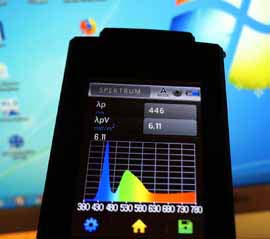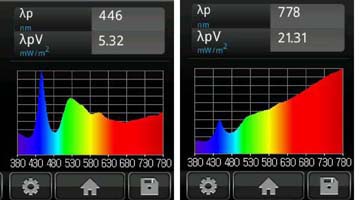
Building biologist measures lightquality of a computer screen
Measured value comparison with different monitor settings
Measured at a distance of five centimeters from the monitor, the Eco-Mode shows an illuminance of 165 lux, while at full screen brightness 235 lux are measured. Surprisingly, the blue light component does not change. The blue light with the wavelength of 498 nanometers (nm) protrudes clearly out of the light spectrum in both monitor settings. The light color is also identical. The reading of 6120 Kelvin gives a clear indication of “cold” light. A clear difference in the screen settings is shown by the flicker quality. The bright monitor achieves a flicker rate of 25%, while the eco-mode setting measures 70% flicker. By contrast, natural sunlight flickers at 0.1 percent. Probably flickering light means stress for the organism. Scientific research over the past thirty years has found that light flicker above all can cause headaches, eye-strain and reduced performance. Strobe light is the most extreme form of flicker. In sensitive individuals epileptic seizures are not excluded.
A bright desk lamp improves the quality of light enormously
In the second step of the light experiment, the building biologist switches on a desk lamp with a halogen bulb. The lamp directly above the monitor increases the illuminance to over 600 lux. The color temperature drops to 3600 Kelvin and thus comes close to warm light. Most noteworthy the flicker improves significantly to 8 percent. The additional light source provides the greatest benefit in assessing the color spectrum (see photo below). The blue light no longer towers over the entire spectrum. Although it still has a small “peak”, but is pushed back by the yellow and the red light in its intensity.

Use a better light intensity in the workplace and reduce the blue light
Summary
A bright additional lighting with a halogen bulb improves the eye-friendliness at the computer workstation enormously. Illuminance, color temperature and color spectrum indicate favorable values. If the user also adjusts the brightness to a high level on the monitor, the flickering of the light decreases significantly.
Read more about light quality
energy-saving-lighting and health
Licht.de (English version)
